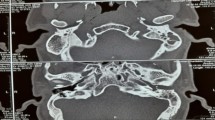Abstract
Three types of etiology behind the granulomatous disease are infective, inflammatory, and neoplastic. Among infective, they are bacterial like (tuberculosis, rhinoscleroma, syphilis, and leprosy) fungal (Rhinosporidiosis, aspergillosis, mucormycosis, histoplasmosis, and blastomycosis) protozoal (leishmaniasis) lymphoma (peripheral T-cell neoplasm/non-healing)midline granuloma and inflammatory vasclitidies like Wegener’s granulomatosis, sarcoidosis, and Churg–Strauss syndrome. Tuberculosis of the nose is usually secondary to pulmonary tuberculosis and involves the anterior part of the septum and anterior end of inferior septum, hence it causes perforation in the anterior cartilaginous part of the septum. Diagnosis is by biopsy and AFB stain ant treatment is anti-tubercular drugs. Lupus is a low grade tubercular infection of the nose. Rhinoscleroma is caused by Klebsiella rhinoscleromatis and Mikulicz cells and Russell bodies are diagnostic findings of biopsy. Acquired and congenital syphilis can be seen in the nose. Congenital syphilis either presents early after birth as snuffles or late as gummas. Among acquired tertiary syphilis is most common. Gummas are seen on the nasal septum and cause perforation in both the bony and cartilaginous septum. Antibiotics given are benzathine penicillin and doxycycline. Leprosy also involves the anterior part of nasal septum and anterior end of inferior turbinate and this leads to perforation in the cartilaginous part. The fungal infection of the nose (Aspergillus fumigates, Aspergillus flavus, Aspergillus niger, Mucor, and Rhizopus) can lead to granuloma formation. Rhinosporidiosis is caused by Rhinosporidium seeberi identified to be an aquatic protistan protozoa (unicellular) parasite. Nasal biopsy or smear shows sporangia. Treatment is wide excision and cauterization of the base. Dapsone is given in the postoperative period to decrease the chances of recurrence. Wegner’s granulomatosis vasculitis is affecting most commonly the upper and lower respiratory tract (multiple bilateral cavitary lesions in the lungs) and the kidneys. Nasal involvement may lead to perforation of both bony and cartilaginous part of septum and ultimately whole septal destruction, saddle nose, or nasal airway stenosis. The cytoplasmic antineutrophil cytoplasmic autoantibody test is highly sensitive for Wegener’s granulomatosis but negative test does not exclude the diagnosis. The main agents used to treat Wegener’s are cyclophosphamide, methotrexate, and/or glucocorticoids. Approximately 40% patients have granulomatous changes in extrapulmonary organs of patients with sarcoidosis. Diagnosis is made on biopsy along with serum Angiotensin-converting enzyme levels. Biopsy is necessary for the definitive diagnosis of T-cell lymphoma and radiotherapy and chemotherapy are used for treatment.
Access this chapter
Tax calculation will be finalised at checkout
Purchases are for personal use only
Similar content being viewed by others
References
Verma H, Panda S, Sikka K, Irugu DVK, Thakar A. Primary spheno-petro-clival tuberculosis. Indian J Otolaryngol Head Neck Surg. 2019;71(Suppl 3):1796–9.
Fischer M. Leprosy – an overview of clinical features, diagnosis, and treatment. J Dtsch Dermatol Ges. 2017;15(8):801–27.
Mukara BK, Munyarugamba P, Dazert S, Löhler J. Rhinoscleroma: a case series report and review of the literature. Eur Arch Otorhinolaryngol. 2014;271(7):1851–6.
Tsang SH, Sharma T. Syphilis. Adv Exp Med Biol. 2018;1085:219–21.
Fernández-López C, Morales-Angulo C. Otorhinolaryngology manifestations secondary to oral sex. Acta Otorrinolaringol Esp. 2017;68(3):169–80.
Almeida FA, Feitoza Lde M, Pinho JD, et al. Rhinosporidiosis: the largest case series in Brazil. Rev Soc Bras Med Trop. 2016;49(4):473–6.
Vega Braga FL, Machado de Carvalho G, Caixeta Guimarães A, et al. Otolaryngological manifestations of Wegener’s disease. Acta Otorrinolaringol Esp. 2013;64(1):45–9.
Kohanski MA, Reh DD. Granulomatous diseases and chronic sinusitis, Chapter 11. Am J Rhinol Allergy. 2013;27(Suppl 1):S39–41.
Send T, Tuleta I, Koppen T, et al. Sarcoidosis of the paranasal sinuses. Eur Arch Otorhinolaryngol. 2019;276(7):1969–74.
Seccia V, Baldini C, Latorre M, et al. Focus on the involvement of the nose and paranasal sinuses in eosinophilic granulomatosis with polyangiitis (Churg-Strauss Syndrome): nasal cytology reveals infiltration of eosinophils as a very common feature. Int Arch Allergy Immunol. 2018;175(1–2):61–9.
Allen PB, Lechowicz MJ. Management of NK/T-cell lymphoma, nasal type. J Oncol Pract. 2019;15(10):513–20.
Tse E, Au-Yeung R, Kwong YL. Recent advances in the diagnosis and treatment of natural killer/T-cell lymphomas. Expert Rev Hematol. 2019;12(11):927–35.
Ryu G, Cho H, Lee KE, et al. Clinical significance of IgG4 in sinonasal and skull base inflammatory pseudotumor. Eur Arch Otorhinolaryngol. 2019;276:2465–73.
RA S, Kaliner MA. Nonallergic rhinitis, Chapter 14. Am J Rhinol Allergy. 2013;27(Suppl 1):S48–51.
Chen HS. Desquamation and squamotransformation of rhinomucosa as a prodromal sign of atrophic rhinitis. J Otorhinolaryngol Related Specialties. 1984;46(6):327–8.
Taylor M, Young A. Histopathological and histochemical studies in atrophic rhinitis. J Laryngol Otol. 1961;75:574–89.
El-Anwar MW, et al. Surfactant protein A expression in chronic rhinosinusitis and atrophic rhinitis. Int Arch Otorhinolaryngol. 2015;19(2):130–4.
Bist SS, Bisht M, Purohit JP. Primary atrophic rhinitis: a clinical profile, microbiological and radiological study. ISRN Otolaryngol. 2012;2012:404075.
Ly TH, deShazo RD, Olivier J, Stringer SP, Daley W, Stodard CM. Diagnostic criteria for atrophic rhinosinusitis. Am J Med. 2009;122(8):747–53.
Mishra A, Kawatra R, Gola M. Interventions for atrophic rhinitis. Cochrane Database Syst Rev. 2012;2:CD008280.
Young A. Closure of nostrils in Atrophic Rhinitis. J Laryngol. 1967;81:514–5.
Sharan R. Transplantation of the maxillary sinus mucosa in atrophic rhinitis. Indian J Otolaryngol. 1978;30:14–6.
Fonseca RJ. Oral and maxillofacial trauma. 3rd ed. St. Louis, MO: Elsevier; 2018.
Kochar HS. An innovative approach to external fixation of severe nasal bone fractures with orthopedic plates. Ear Nose Throat J. 2011;90:102–4.
Chen CT, Chen YR. Endoscopically assisted repair of orbital floor fractures. Plast Reconstr Surg. 2001;108:2011–8.
Author information
Authors and Affiliations
Corresponding author
Editor information
Editors and Affiliations
Rights and permissions
Copyright information
© 2021 The Author(s), under exclusive license to Springer Nature Singapore Pte Ltd.
About this chapter
Cite this chapter
Gupta, G., Nayak, P.D., Silu, M., Singh, S.N., Kocher, H. (2021). Granulomatous Disease and Faciomaxillary Trauma. In: Verma, H., Thakar, A. (eds) Essentials of Rhinology. Springer, Singapore. https://doi.org/10.1007/978-981-33-6284-0_4
Download citation
DOI: https://doi.org/10.1007/978-981-33-6284-0_4
Published:
Publisher Name: Springer, Singapore
Print ISBN: 978-981-33-6283-3
Online ISBN: 978-981-33-6284-0
eBook Packages: MedicineMedicine (R0)




